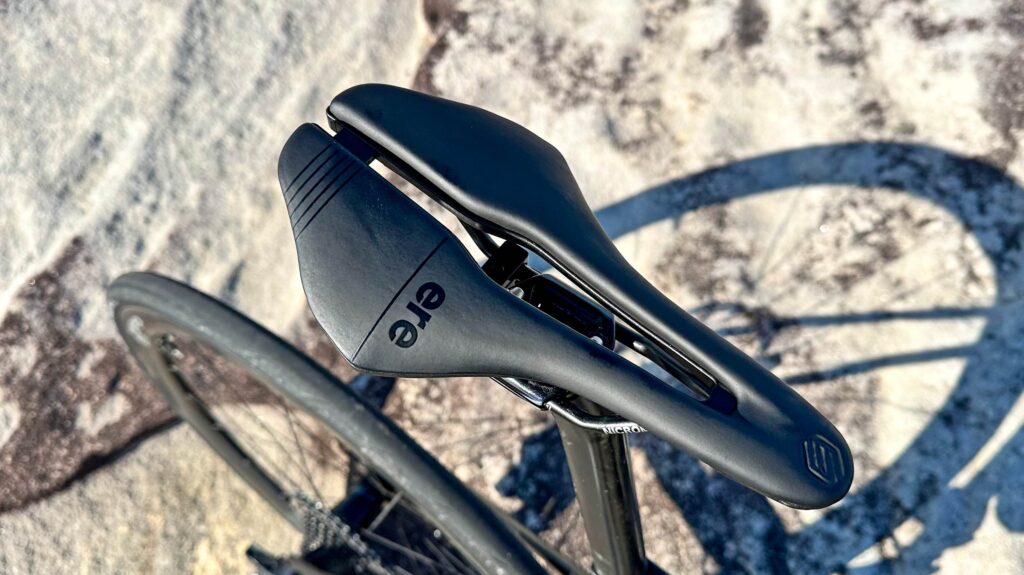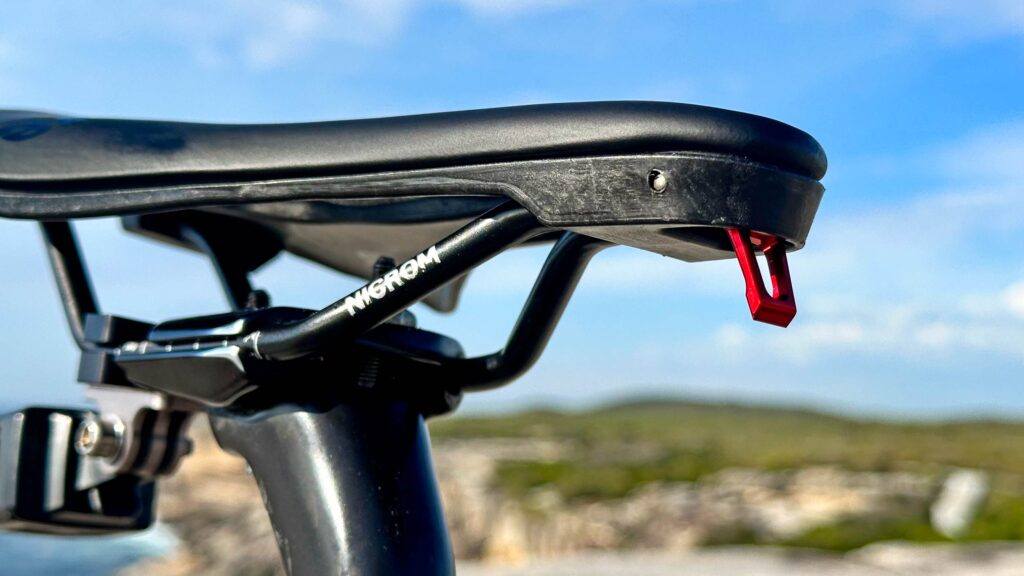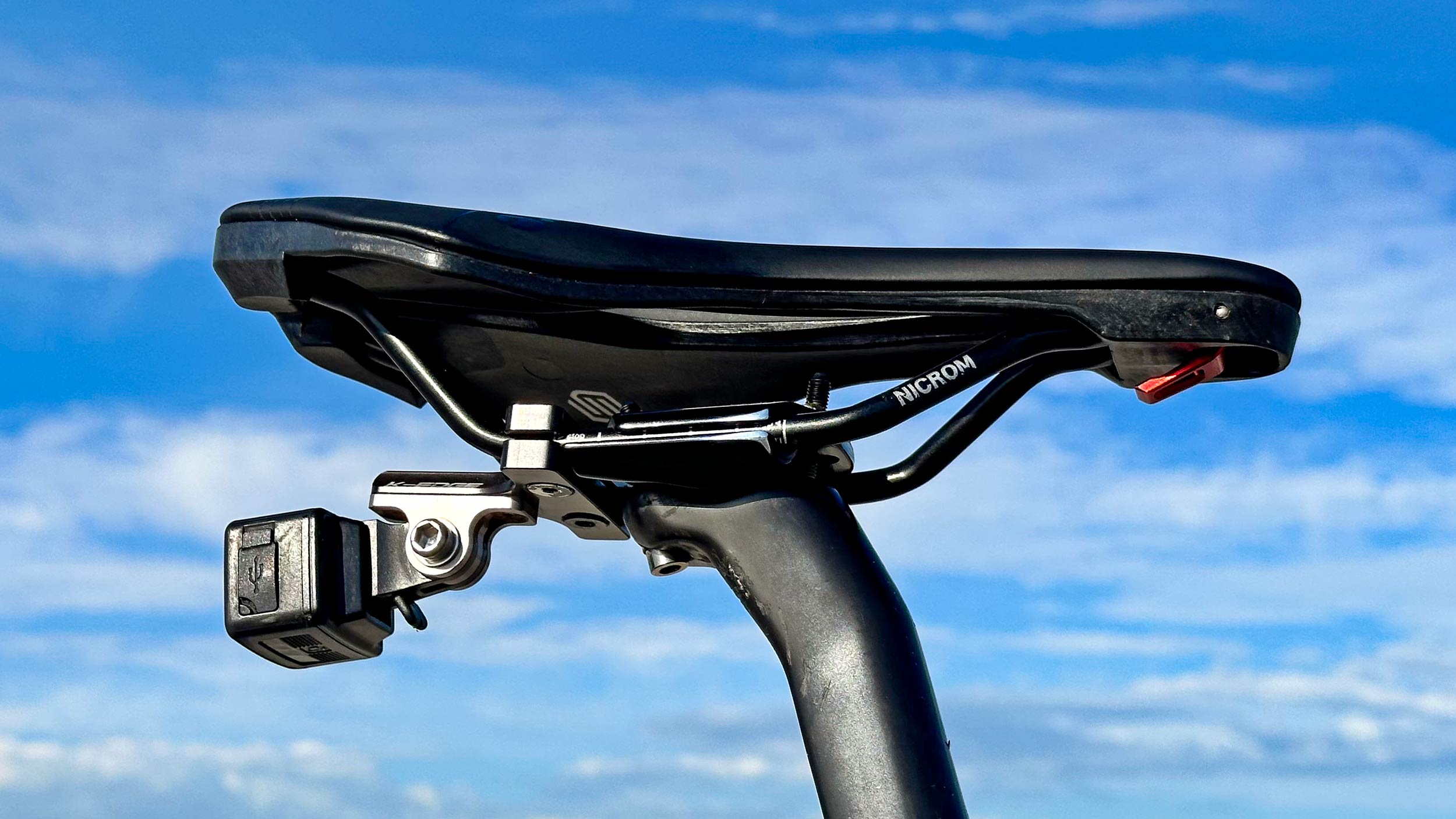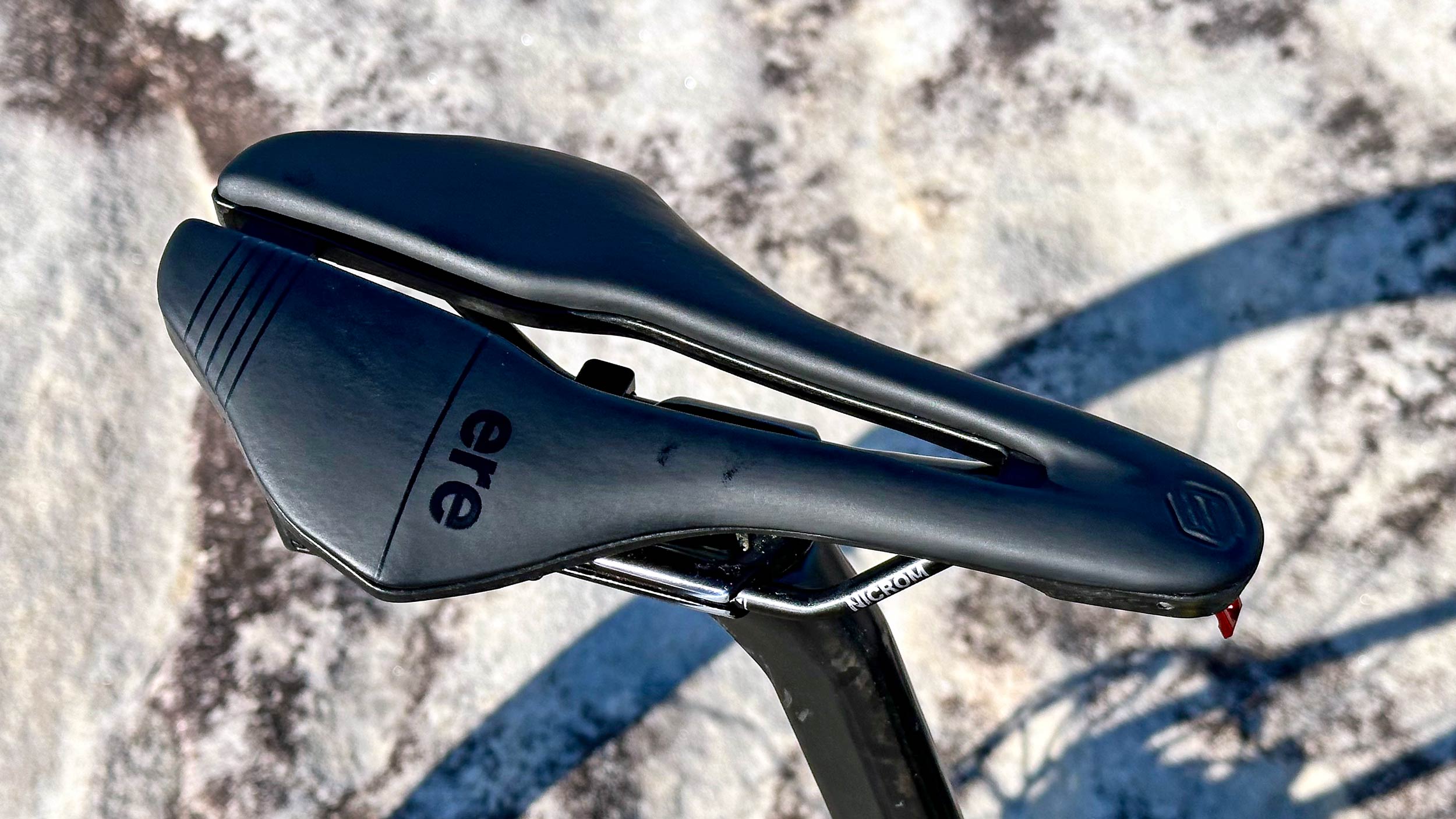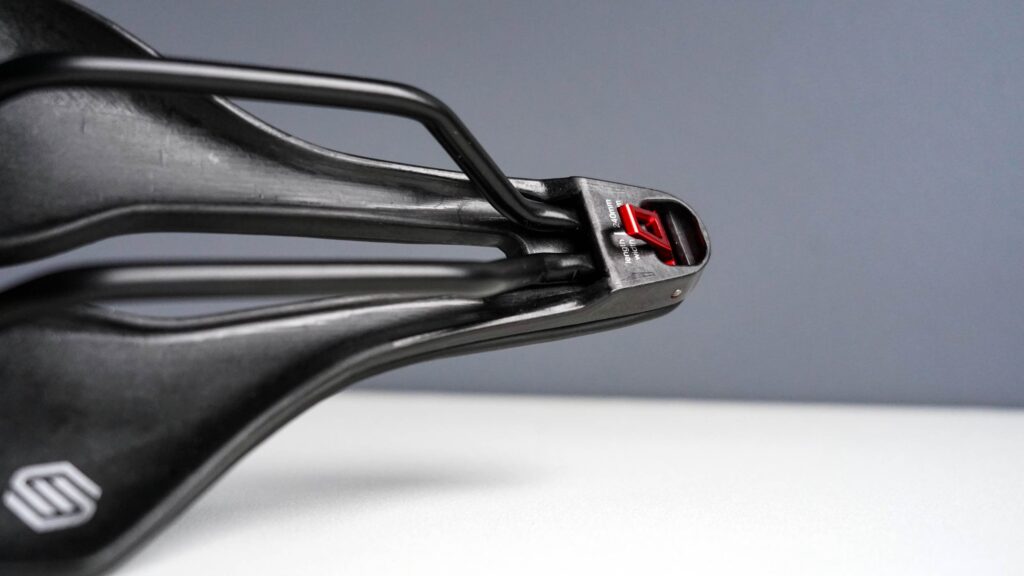Cycling saddle shapes and sizes have evolved considerably in recent years and Ere Research has launched a range that includes a ‘Comfort Trigger System’, offering on-the-go adjustments with the aim of providing a smooth ride…
Words and photos by Rob Arnold
Ere Research is a relatively new company offering a wide range of cycling components for you and your bike. Distributed in Australia by De Grandi Cycle and Sport, Ere items were recently on display in the TDU Expo area and RIDE Media has a few products to review, including a small 203 gram Genius T saddle with what Ere call a ‘Comfort Trigger’.
The little red nodule you can see at the front of the review saddle (pictured) is the trigger, and it allows riders to adjust the tension – and, so the theory goes, change the comfort level – with a minimum of fuss.
There are three settings for Ere saddles that feature the trigger: ‘full tension’, ‘medium tension’ and ‘fully de-tensioned’. The idea is that, with a simple push of the lever, riders can select the right setting for the road surface they are on (or to match a preference of feedback through the sit bones).
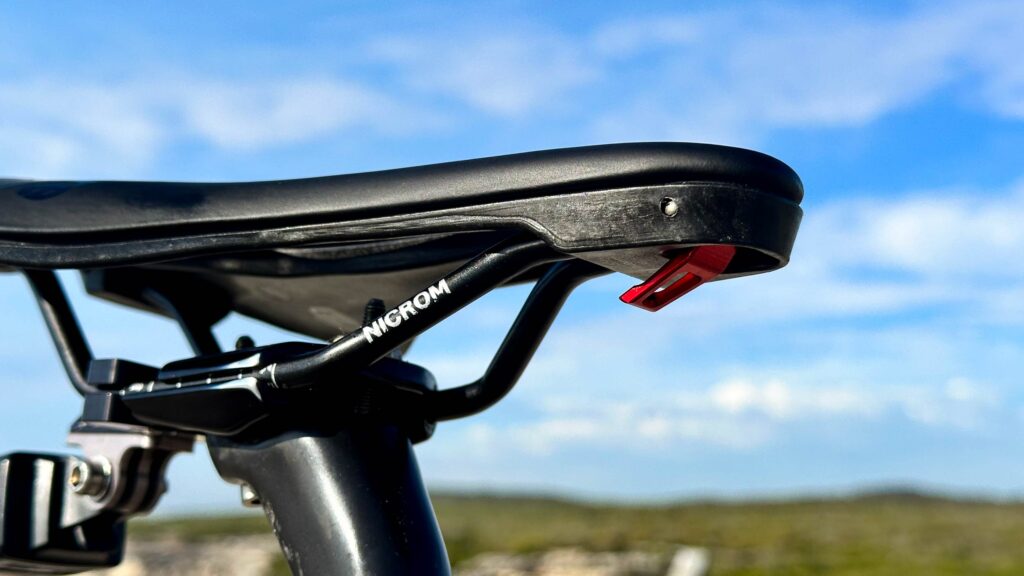
The photos above show the ‘Comfort Trigger’ in the two extreme position – ie. ‘fully de-tensioned’ or ‘full tension’.
The review saddle is one of the base models, with chromoly rails and other characteristics common on modern bike seats, albeit in a size that is considerably smaller than most other saddle designs on the market. The dimensions are 240mm long and 130mm at the widest section, making is the smallest saddle I’ve used since the rudimentary BMX micro-saddles of my youth (ie. many moons ago).
Something that struck me as odd during the first few kilometres using the Ere saddle, is how there was never any sense that something was missing; it wasn’t at all apparent that the saddle was notably smaller than what I have been riding these past few months (ie. a new-generation Fi’zi:k Alianté, 275mm long and 145mm wide).
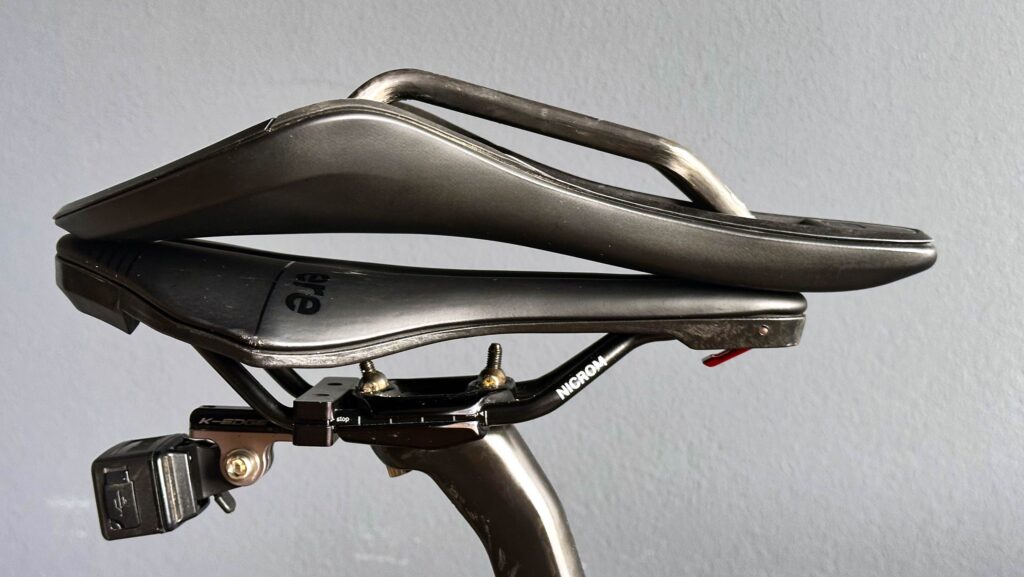
Flipping the Fi’zi:k Alianté upside down and placing it on top of the Ere Genius T to illustrate the difference in length… the top saddle is 275mm long, the bottom is 240mm.
Although smaller than ‘typical’ saddles, there is still plenty of scope for adjustments with ±75mm of usable rail (compared with ±80mm on the Alianté). Still, some logic was applied when swapping the saddles, as it wasn’t possible to just take measurements from my Fi’zi:k set-up because of the significant size discrepancy.
As you see it here, the rear of the Ere Genius T is ±17mm further forward than my Alianté set-up. This means the nose of the new saddle is further back than I’ve been used to but it all seemed totally natural even from the first few pedal strokes. My guesstimate during the fitting, it seems, was close to spot-on. Not once was I compelled to stop during my maiden ride and tweak the saddle’s position.
Initial impressions: minimal differences
Within minutes of my first ride with the Ere Genius T, I pulled the trigger to see if I could notice any difference in feedback from the road. I did this while sitting upright (and talking to the camera, which you will see in a future review on RIDE Media’s YouTube channel). Of course, I bounced around a bit attempting to feel the difference… but frankly, it was negligible.
The principle of the design seems sound: if you ease the tension of the saddle’s rails, then surely the feedback from the road also quells. But there are other factors at play, including the use of 32mm Goodyear tyres inflated to around 58psi (on Zipp 303 wheels), as well as the slight flex of the proprietary seatpost that comes with my Focus Izalco Max bike.
In other words, there are plenty of features on modern bikes that impact ride comfort.
It wasn’t until later in the ride that I realised the benefit of switching the trigger from one setting to the other.
When sitting upright (as per my initial bounces on the saddle) your bum also soaks up more shock than when your hands are on the handlebars, when your sit bones take more of the impact from the saddle. And so, in the riding position, the benefit of the trigger was indeed more discernible.
Don’t expect suspension
When the trigger is in the forward position, there is less tension on the rails and therefore a little more give in the saddle. Push the trigger backwards and you can feel two distinct points of engagement: the first when the lever is at the midway point, the second when it’s at the end of the arch, which is when the saddle tension is the most extreme.
It wasn’t possible for me to document the differences between one trigger position at the next. Even super slo-mo images aren’t going to showcase the level of give the saddle offers (at least not when you are both riding and filming, as I tried to do on my first ride). But when I rode for a while with the trigger at both extremes (largely ignoring the mid-tension option) and it was possible to feel the difference.
Don’t expect a huge dose of additional comfort. This is not a suspension system, per se. Rather is a way of ironing out the rougher stuff if, for example, you’re going from smooth bitumen to gravel. The advantage is that you can make minor adjustments while on your ride and that can be of benefit for longer days on the saddle.
Small but comfortable
The ‘Comfort Trigger’ is a selling point of the saddle but the smaller size is, in my appraisal, the more obvious feature that differentiates the Ere offerings from other designs. The range includes saddles with chromoly, titanium or carbon-fibre rails and this is likely to change the ride characteristics as well as weight.
For years I was reluctant to swap saddles, even when reviewing different bikes but in the past year I’ve tried a wide range of brands and shapes and I’m yet to use one that really annoys me. Long or short, wide or narrow, padded or minimalist… modern saddles are usually either good or better. The trick is simply finding the style that suits your body and riding style.
Some saddles I’ve tried lately have required some tiny angle adjustments before I’ve found the optimum position. There is a trend of a slight nose-down tilt (rather than the traditional arrangement, ie. parallel to the ground) and I’ve adopted that approach with some saddles in the Repenté range as well as with the new Shortfit 2.0 3D Carbon FX from Selle San Marco.
For this review saddle, I took a more traditional approach when setting it up (ie. very slight downward tilt) and that suited me perfectly.
At 203g, the review saddle is heavier than others I’ve used recently (most of which have had carbon rails) but it’s hardly a clunker. Spend a bit more with Ere and, as with other brands, the weight comes down – and you are also probably going to get different sensations when you pull or push the trigger.
– By Rob Arnold


